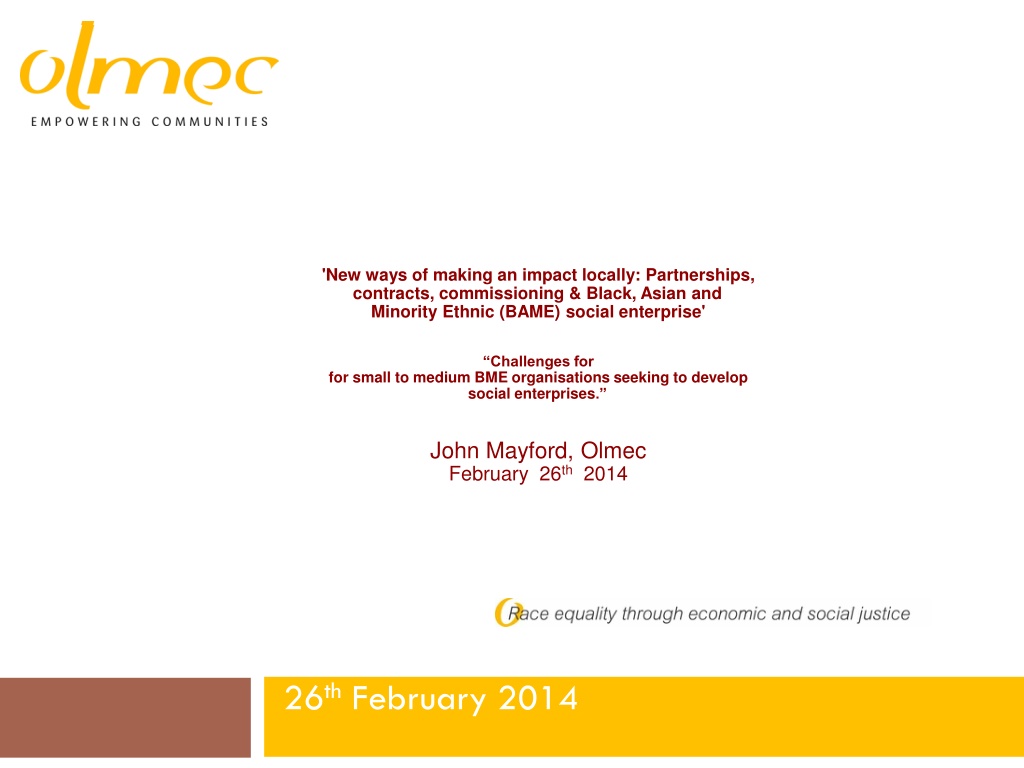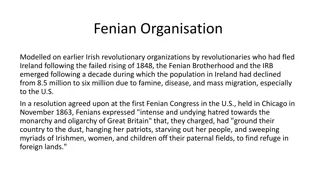
Impactful Ways for BME Organizations to Develop Social Enterprises
Explore challenges and opportunities faced by small to medium BME organizations in building social enterprises, including issues of discrimination, lack of social capital, and building networks. Learn about what social enterprises are, how they function, and their significance in creating social change.
Download Presentation

Please find below an Image/Link to download the presentation.
The content on the website is provided AS IS for your information and personal use only. It may not be sold, licensed, or shared on other websites without obtaining consent from the author. Download presentation by click this link. If you encounter any issues during the download, it is possible that the publisher has removed the file from their server.
E N D
Presentation Transcript
'New ways of making an impact locally: Partnerships, contracts, commissioning & Black, Asian and Minority Ethnic (BAME) social enterprise' Challenges for for small to medium BME organisations seeking to develop social enterprises. John Mayford, Olmec February 26th 2014 26thFebruary 2014
Challenges for small to medium BME organisations seeking to develop social enterprises. 2 Social Enterprise Sector Opportunities Challenges to starting up a social enterprise Where you can go to for help Some case studies www.olmec-ec.org.uk
Challenges for small to medium BME organisations seeking to develop social enterprises. 3 Two sets of challenges face BME communities & individuals setting up social enterprises social capital issue of having networks and absorbing knowledge about how banking, infrastructure, markets and the statutory sector work. Statically, there are issues of discrimination faced by migrants of all ages: a 2012 report by Deloitte indicated that in the UK, white graduates are three times more likely than graduates from ethnic minority communities to be offered a position by a top British company. As any other businesses, co-operatives face fierce competition, and need to negotiate issues such as market volatility and product-sourcing. A survey in 2000 completed by 40 FTSE 100 companies showed that only 1% of senior management positions were held by people from ethnic minority communities and unemployment rates for ethnic minority communities are on average two to three times those of white communities. Lack of social capital Inequalities & discrimination in society 55% of young black men are unemployed www.olmec-ec.org.uk
Social Enterprise: what is it? 4 Simple Definition We all know and buy from social enterprises in our everyday life A business that trades to achieve explicit social aims 15 Foundation (Jamie Oliver) Co-op Bank Interflora London Symphony Orchestra John Lewis Definitions can sound dry but social enterprises create social change and begin with the dreams and aspirations of people and communities Co-operative supermarket Equal Exchange CIS insurance Majority of Doctors surgeries Credit unions Tom s shoes www.olmec-ec.org.uk
Social Enterprise: What is it? SOME DEFINITIONS A social enterprise is a business that trades to tackle social problems, improve communities, people s life chances, or the environment. This might sound like charity work, but social enterprises are businesses and when they profit, society profits Exists to tackle a social or environmental problem Makes its money from selling goods and services Reinvests its profits back into the business or the local community But does not exist to make profits for shareholders make its owners very wealthy Definition from socialenterprise.org.uk
Social Enterprise: an example of a business type and legal form 6 Legal form: Co-ops can be Companies Community Interest Companies Industrial and Provident Societies Business type: Co-op Co-operative Principles Open and voluntary membership One member one vote Member economic participation http://www.uk.coop/simplylegal Autonomy and independence http://www.uk.coop/simplygovernance Social enterprises can use Education and training Co-operation with other co-operative Charitable legal form Social alongside economic aims LLP Can operate as . Mutuals (community, mutual self help, members are beneficiaries) www.olmec-ec.org.uk
Social Enterprise: a definition: please dont confuse business type with legal form!! 7 Legal form / structure (2006) Business Type: Social enterprise Community Interest Company Has to pass a community interest test and restricted by the powers of the governing document BIS(DTI) definition 2002 a business with primarily social objectives whose principally reinvested for that purpose in the business or in the community, rather than being driven by the need to maximise profit for the share holders and owners. surpluses are Regulated by CIC regulator within Companies Houses www.olmec-ec.org.uk
Social Enterprise: what is it? 8 Organisational model / Questions that will determine legal form Who owns or controls it and how? Legal forms Unincorporated Association Unincorporated Charity Trust Charity (Company Limited by Guarantee, CIO) Company Limited by Guarantee Company Limited by Share Community Interest Company (Guarantee or Share) Society for the Benefit of the Community Co-operative Society LLP Connected to social purpose and why it exists? Co-operative / mutual (community, mutual self help, members are beneficiaries) Trust / charity / beneficial (help others, beneficiaries receive, on behalf of members) Social Entrepreneur (individual, help self while help others, beneficial) Service users or beneficiaries? What type of investment is needed? Debt investment? Equity investment? Social Impact bonds (new asset class)? What are your plans for growth? Bigger operation? Social franchising? How will surpluses be invested or distributed? www.olmec-ec.org.uk
Opportunities: a look at the size of the sector 10 Over Co-ops with 12.9 million members, providing 237,800 jobs turnover of 36.7 billion (2014 figures) Small Business Survey (SBS) estimated in 2005 that 1.2 per cent of all business were Social Enterprises, equating to 15,000 business 27 billion turnover The Social Enterprise UK(formerly Social Enterprise Coalition) used later SBS data to calculate that by 2009 there were approximately 62,000 social enterprises in the UK. 80,000 in 2013 Delta Economics employ a wider definition of social enterprise estimating that the sector provides over 2.09m jobs in the UK economy raising the figures of SE s to 232,000. Olmec takes this big tent definition of social enterprises, sharing Delta s broader perspective. It is clear from these figures that social enterprise is playing an increasingly significant, if not mainstream role in the UK economy. www.olmec-ec.org.uk
Opportunities in social enterprise 11 Growing Concerns is a social enterprise which is part of Old Ford's Community Development Team. Growing Concerns is a community-based gardening and landscaping team dedicated to improving the environment for those living and working in London s East End. Furniture on the Street supplies high quality contemporary street furniture aimed at local authorities, housing associations, landscape designers and building contractors. The enterprise was set up by The Invisible Man, a design business committed to supporting youth development. This was originally for Old Ford Housing Association in 2005. The enterprise is now based at the Bromley By Bow Centre in east London. Growing Concerns Garden Centre - Grounds Maintenance service offered to other Registered Providers and private developers Bespoke Design and Build service to private clients Children's' workshops on-site http://growingconcerns.org/plant_hire www.olmec-ec.org.uk
Challenges facing a social enterprise 12 Product/service Market Business model Investment Understanding of break even Marketing strategy Legal vehicle organisation/legal status Operational management Good governance Business plan www.olmec-ec.org.uk
First Steps in Social Enterprise Case Studies First Steps Beneficiary My social enterprise idea is to develop a business which provides creative personal development and cultural experiences to disadvantaged and disempowered women from migrant backgrounds, and the wider community. The business will offer quality bespoke training programmes, combined with cultural and social experiences to empower women to achieve, enjoy, and live their lives fulfilled. www.communityhand.com Inspired by social purpose objective to reduce the deaths from knife crime and reduce admittance of children to A&E by offering free First Aid and Paediatric Training to the London Community. Community Hand worked with Schools, Nurseries and a Church in Haringey and a Children s Centre in Kent, trained 150 people since February, including young children, teenagers and parents. offer coaching programmes to help build self- confidence, self-esteem, and self-worth Commmunity Hands commercial objective is to offer First Aid (and other) courses to public and private sector companies, and invest surpluses into the community by providing free training to schools, nurseries and community and voluntary sector providecultural and social networking activitiesto enable women to develop sustainable support networks provide workshops which offer support with basic skills (literacy and IT) About to re-launch the website and have applied the learning from the programme to the business model Won a Star People Award from Unlimited with a grant of 5000
Introduction to social enterprise 15 John Mayford, Chief Executive. Olmec 0207 688 8019 www.olmec-ec.org.uk www.olmec-ec.org.uk





















